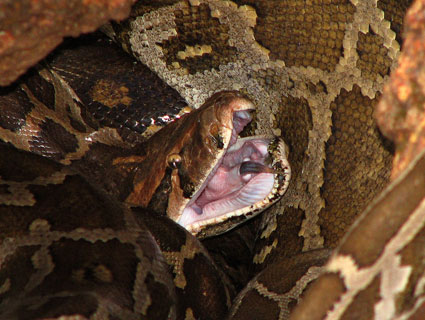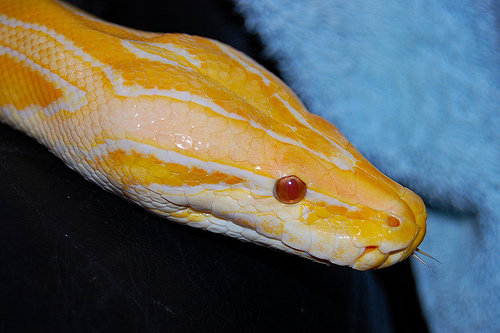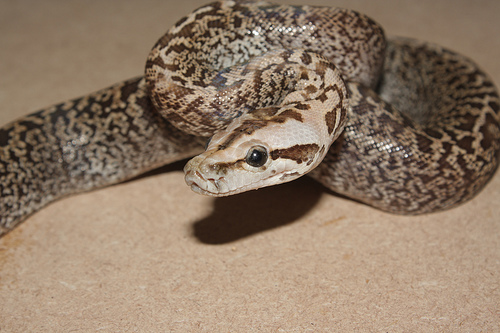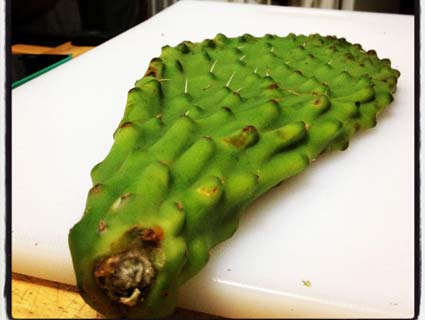
<a href="http://www.flickr.com/photos/krayker/2127435092/">wildxplorer</a>/Flickr
Les Gibson takes me out to teach me how to hunt, which is what he calls fishing. Despite the fact that every public beach in Queensland, Australia, has been periodically closed this season due to blooms of box jellyfish, and despite the fearsome saltwater crocodiles living here, Les strides confidently into the bay with a pair of 10-foot-long bamboo spears and his wooden woomera, the multipurpose Aboriginal atlatl, or spear-thrower.
When I ask him if he worries about jellyfish, he tells me Aborigines have a cure for the venom. Do scientists know about this cure? I ask. No, he says, they never ask us anything.
We wade waist deep through water as warm as a bath, Les pointing out schools of mullet, schools of goatfish, a stonefish, a pipefish. I’m wearing polarized sunglasses and have spent much of my life peering through water, yet I can’t see what Les sees. Deftly as a striking heron, he loads the woomera and tosses a spear through the surface. It disappears, then jerks up, thrashing with the struggles of an impaled mullet. Clubbing the fish with the woomera, he stuffs it in the back pocket of his shorts, so that now we are wading in waist-deep water in prime crocodile and shark habitat leaking fish blood.
In a staccato dance—darting and stopping, tossing the spear, collecting, darting again—Les goes after a blue-spotted lagoon ray and a baby gray reef shark. Somehow he spears the shark intentionally through its pelvic fin, then lifts it to the surface on the tip of one spear and skewers it through the second pelvic fin with his second spear. Thus immobilized, it becomes my combination science-and-culinary lesson, Les pointing out its anatomy while describing favorite recipes. Lesson over, he lets it go, not too much the worse for wear.
He points out a lionfish. That feller is far from home, he says. He gestures offshore, where the sea grows darker and mottled by the Great Barrier Reef. I have just come in from weeks of diving at pinnacles and coral heads loaded with venomous lionfish.
Les is not worried about them either. There’s a treatment. Just like there was a treatment for my skin, for a rash of welts and bites garnered in a month of living outdoors and underwater. This morning he cured me. We stood in seawater to our knees, Les rolling between the palms of his hands a mass of yangga (green ants) and their leafy nest, stripped off a bush he calls the soapy tree. Crushing ants and leaves, he added a trickle of seawater, rolled some more, repeated, until the whole mass started to foam.
Getta whiff, he said, holding it under my nose. Clears the sinuses. Keeps the bugs away. I slathered the mentholated salve over my skin—like rubbing a magic eraser over my torments.
Now Les wants me to try hunting. I throw the spear, but also the woomera, a real idiot move. Eventually I get the hang of it—though I’ll never hit anything. No matter how hard I squint, I can’t match Les’ acuity, even with the milky blue cataracts clouding his 65-year-old eyes.
Les’ wife, Marie, shows me how to drag chairs from their beach shack and stack them so I can reach the fruit of the tree she calls banday. The berries are as sweet as pineapple. But the one they call white apple, the one they love best, they never see it anymore. And this, she says, cupping another fruit in her hand, this tree came to the beach, and all these fruit hanging here. They’re no good.
I recognize the tree and the fruit. It’s a pond apple, native of the Florida Everglades. Here it’s a weed, one of Australia’s worst, an invasive species bullying the marshy ecosystems of Queensland by growing so fast, tall, and thick, it’s driving out beloved natives like melaleuca trees. I spent the better part of four years filming in the Everglades, including pond apples and the bullying done to them by invading Australian melaleuca trees growing faster, taller, and thicker than Florida’s beloved native pond apples. If there’s such a thing as biological irony, this is it.
Les and Marie are Guugu Yimithirr, descendants of Australians Captain James Cook made contact with near here in 1770. Other Europeans followed, along with their symbionts: pigs, cattle, sheep, rabbits, cats. The arrivals proved cataclysmic to all the human cultures inhabiting this island continent, as well as to the native birds, reptiles, mammals, insects, and plants—destroying a hundred millennia of deep ecological dialogue.
The problem didn’t end there. Nowadays when species obey the commandment to “be fruitful and multiply, to fill the waters in the seas, to let the birds multiply on the Earth,” all is decidedly not good. Proliferation on a biblical scale generally signals biological apocalypse, what scientists call invasion—the establishment and spread of introduced species in places they’ve never lived before. Species have always been on the move. But they’ve also been held in check by Earth’s geographical barriers, like mountains and oceans. Today the rate of invasions has skyrocketed because of our barrier-hopping technology—jets, ships, trains, cars, which transport everything from mammals to microorganisms far beyond their natural ranges. The process is further accelerated by global climate change, that enormous human experiment unwittingly redistricting the natural world.
The results devastate both planetary and human health—most disease organisms, from influenza to malaria, are invaders over most of their range—and few invasions can be stopped once they’re successfully established. Biological invasions are now second only to habitat loss as a cause of extinction—the leading cause of the extinction of birds and the second-leading cause of the extinction of fish. Twenty percent of vertebrate species facing extinction are doing so because of pressures from invasive predators or competitors. In a classic example, brown tree snakes arrived in Guam (snakeless but for a worm-sized insectivore) sometime after World War II and systematically ate 15 bird species into extinction while consuming enough small reptiles and mammals to redesign the food web. They also began traveling an expanding network of power lines, electrocuting themselves and causing about 200 power failures annually. In all, invasive species are estimated to cost $1.4 trillion each year.
Islands are critically vulnerable to invasions. The giant African snail, introduced to Hawaii in the 1950s, became a worrisome enough pest that government managers introduced another 15 nonnative snails over six years in an effort to control it. One, the rosy wolfsnail, preferred native Hawaiian snails, consuming 15 of 20 species on Oahu into extinction and leading to an entire genus awarded a listing under the Endangered Species Act. A virtual carbon copy of this disaster took place in Tahiti and the other Society Islands, where the rosy wolfsnail obliterated 56 of 61 native snails.
Pull back far enough, however, and everything is an island. Lakes are islands of water. Mountains are elevational islands. Continents are really big islands. Oceans are vast islands of seawater. In fact, all the landscapes and waterscapes of Earth now shattered by human use are islands afloat in seas of development. These fragments offer none of the benefits of isolation, only the weaknesses. In one measure of just how frighteningly fruitful and multiplicative these incursions have become, the rate of successful invasions in San Francisco Bay rose from about one a year between 1850 and 1970 to one every 14 weeks in the 1990s. Our best hope of addressing this deadly fecundity is to stop it before it starts, and that requires understanding all the strange new ways that species have come to hitchhike on our ride.
The red lionfish (Pterois volitans) is a creature of indescribable loveliness, a one-foot-long lacy, plume-bearing extravagance of a fish, complete with red, white, and gold stripes along its body, with wispy fins that look like feathers—hence its other common name, the turkey fish. It’s a deadly presence on the coral reef, bearing glands at the base of its “feathers,” injectable through its “quills,” full of potent toxins. Human symptoms of envenomation include intense pain, tingling, blistering, and the possibility of worse—nausea, vomiting, abdominal pain, headache, delirium, seizures, paralysis, respiratory distress, congestive heart failure.
In their native Pacific waters, red lionfish tend to sleep by day, head down under ledges. But at night, they join a cast of nocturnal heavy hitters: sharks on the prowl, barracuda on the hunt, moray eels free swimming in pursuit of prey, sea snakes forgoing their daytime friendliness for serious underwater slithering. Shining my dive torch out into the black, I catch these players sidewinding through the beam like images from an old-time magic-lantern show, vignetted by darkness.
But I don’t have to sweep the night for lionfish. They come up close, hovering in midwater, feathers waving hypnotically, staring at me head-on, the stripes on their bodies running right through their independently twirling eyeballs. I begin to think of them as the skunks of the coral reef, perfectly defended, small but invincible, curious, busy, undaunted by size. Few animals live unafraid. Lionfish may be one of them.
They may also be the only animals to use what I call entrancement as a hunting method. Victims seem to fall prey to the fluttering dance of the lionfish’s wings as they’re unwittingly herded into dead-end corners and narrow alleys. On moonlit nights with my torch turned off, I’ve seen lionfish stalking cardinalfish or other plankton pickers, waving their feathery veils to cull one fish from the school, stalking it in mesmerizing slow motion before suddenly and violently extending protrusible jaws, grabbing and suctioning all at once. In filmmaking parlance, it’s a jump cut: First there’s a little fish, then there isn’t, and you never even see the middle part of the action.
Lionfish are near-ubiquitous predators on coral reefs of the Indian and Pacific oceans and are part of ancient ecological interactions. Everything from lobsters to soldierfishes knows to give these seductive fan-dancers of the night a wide berth. So what happens when you take coral-reef animals that have never seen lionfish and put them together with lionfish? Aquarists know. It’s War of the Worlds: aliens with superior technology knocking over the hapless natives and feasting on their remains. It’s science fiction. Except now it isn’t.
In 1992 a small and intensely powerful Hurricane Andrew roared through south Florida like a 25-mile-wide tornado with gusts of up to 165 miles per hour. The storm was one of only three Category 5 hurricanes to make landfall in the US in the 20th century, striking hard at Biscayne Bay on Florida’s east coast. Somewhere along that ravaged shoreline, in some expensive glass-fronted mansion or a humble beach shack, the 17-foot storm surge punched open an aquarium and released a few red lionfish, perhaps only six individuals. Despite formidable conditions in the wake of the hurricane—scouring waves, a month of choking turbidity and ongoing fuel spills from hundreds of damaged boats—the lionfish apparently took hold and multiplied. And multiplied and multiplied.
Three thousand miles from invasion ground zero, Mark Hixon is a professor of marine conservation biology at Oregon State University, a campus 50 miles from the sea, and an unlikely place to find a specialist in coral-reef ecology. He admits it was hard at first, living so far from the ocean. But this school is a hotbed of science and no stranger to environmental controversies, including the spotted owl wars of the 1990s. Hixon has been studying biodiversity on coral reefs since the 1970s. In 2006 he was unwittingly sucked into the hypnotic clutch of the red lionfish when his long-term research sites in the Bahamas were invaded. For a while it appeared this might be a second red lionfish invasion in the Atlantic, perhaps the result of another transport mechanism—ships carrying larval fish in their ballast water. But Hixon highly doubts it, since surveys of exotics off Florida show only popular aquarium fish (emperor angelfish, yellow tang, orbicular batfish) as invaders, not a random sampling of fish from Pacific ports of call, as one would expect if ballast water were the vector. Plus, new genetic research suggests Bahamian lionfish are from the same founder population as Florida lionfish.
For Hixon, the invasion gave his work on protected marine areas new meaning. How to safeguard a protected area from the incursion of an alien? And one spreading like a plague of locusts, he says. Already lionfish have infiltrated Bermuda. They’ve breached New England. They’ve occupied Jamaica and the US Virgin Islands. There are unconfirmed reports of lionfish from Puerto Rico, the Yucatán Peninsula, and the Lesser Antilles. So what, you might say. They’re pretty, they’re reefy, they’re just another fish, right?
Hardly. Hixon and his doctoral student Mark Albins have recorded the lionfish’s disturbing appetites. A single red lionfish on a six-foot-diameter reef ate an average of 79 percent of the resident baby fish during a five-week study period. These tiny juveniles are the stuff of biodiversity, and lionfish are apparently eating four out of five of them, imposing an unsustainable tax on the future. Worse, invasive lionfish have no natural predators, and though there is some evidence that large native groupers in the Atlantic might be learning how to eat them, populations of large native groupers are so severely overfished there simply aren’t enough left to do the job.
Here’s where it gets really strange. Released from the competitive and predatory pressures holding them in check, invaders sometimes become dark superhero versions of their former selves: bigger, faster, tougher, more populous, and behaviorally different than before. In parts of Guam, brown tree snake populations explode to 13,000 per square mile. Australian spotted jellyfish grow nearly twice as big in invaded Gulf of Mexico waters as at home. Argentine ants fight each other brutally in their native world yet become supremely cooperative when transplanted, joining forces to drive local ants into extinction and threatening important bee pollinators. House mice, hitchhikers on human invasions for the past 8,000 years, are masters of behavioral plasticity. On Gough Island in the South Atlantic, groups of up to 10 mice have learned to attack albatross chicks more than 300 times their own size. Because the chicks have never faced terrestrial predators, they offer no defenses, not even when the mice are eating through their body walls and consuming the food in their bellies. In perhaps the most notorious recent invasion, US wildlife managers are fighting a costly and losing battle against Asian snakeheads, since the fish can live up to four days out of water and can walk between ponds and rivers.
Albins and Hixon’s research shows lionfish crowding onto reef sites at the rate of 59 per acre—implying they’re not only swallowing the future, but starving the present as well, since an average-size adult eats about six pounds of fish and crustaceans a year, which translates to about 6,000 baby fish. Hixon and Albins have evidence that lionfish behavior may be changing in their new world, that they may be developing into daytime hunters in the Bahamas, whereas they’re largely nocturnal in the Indo-Pacific. This is alarming on two levels. First, lionfish are likely outcompeting native predators (who must also make a living from the same prey populations), and not just coral-reef predators. In the Atlantic, lionfish are expanding beyond the tropics. Adults have colonized as far north as North Carolina and juveniles are traveling up to Rhode Island—though they die off each winter. Second, along these routes, in both tropical and temperate waters, lionfish are encountering naive species with no experience of their venom or entrancement. Hixon and Albins have observed a single lionfish gobbling more than 20 small wrasses in the space of half an hour. It’s like shooting fish in a barrel. Far from their native world, the lionfish’s impressive tools become weapons of mass destruction.
Hixon mulls the problem constantly—while driving, while walking across campus, eating, socializing. He hopes Bahamian officials can institute a bounty and convince locals that lionfish taste like chicken and are easy to eat once you know how to avoid the spines and cook the fish sufficiently to denature the venom. But until and unless that happens, says Hixon, lionfish may very well become the most devastating marine invasion in human history.
Hurricane Andrew’s havoc did not end at lionfish. Its killer winds tore up the Everglades’ signature sloughs and saw-grass prairies, felling native vegetation and implanting the wracked landscape with tiny seeds of the invasive Australian melaleuca—a lot of seeds, it turns out, since a mature melaleuca can produce more than a million of them per year. Melaleuca were purposely introduced into the Everglades to suck dry “useless” swampland. Unfortunately, by the 1990s, when the swamp had been reimagined as a national treasure, it was too late for the hundreds of thousands of acres desiccated by the invited invaders.
Many successful biological invasions capitalize on mayhem. Both melaleuca and lionfish are what biologists call drivers of ecosystem changes—causing, for instance, changes in biodiversity. But both are also passengers of ecosystem changes, piggybacking on changes already under way: melaleuca on disrupted landscapes, lionfish on overfished reefs. The potential for more powerful hurricanes as a result of global climate change threatens to amplify existing invasions and maybe even foster new ones—a process known as invasional meltdown. Fifty miles to the west of Hixon’s lab, in the waters of the North Pacific, a synergy of ecological changes appears to be fueling the invasion of Humboldt squid—aggressive predators reaching nearly seven feet in length (not counting their tentacles) and 110 pounds in weight, and living in schools hundreds or thousands strong. They are known to ecologists as r-strategists: species that live fast, die young, and breed early and profusely. (Humboldt squid produce up to 32 million eggs per female.) R-strategists, like locusts and rats, thrive in unstable environments since their generational turnaround time is short enough for adaptation and evolution to work their miracles.
At the moment, a seriously unstable world beckons the Humboldt squid. Typically confined to the tropics and subtropics, they’re now moving northward explosively as waters warm, as their main predators, tuna and billfish such as marlin, are overfished, and as global-warming-induced dead zones appear—Humboldt squid are one of the few animals tolerant of their low oxygen levels. Although the squid have not been accidentally released from a home aquarium or carried across the Panama Canal in the ballast water of a ship or towed around on portable oil drilling platforms (as with Australian spotted jellyfish in the Gulf of Mexico), they are nevertheless invading new realms and are now established as far north as the once-chilly Gulf of Alaska.
Clearly Humboldt squid are passengers on ecosystem changes already under way. But they may be drivers as well. Their move north coincides with the decline of Pacific hake, the West Coast’s most important commercial groundfish. Are they gorging on hake as they grow from hatchlings smaller than a grain of rice to seven-foot adults in only a year, maybe two? Whatever they’re eating, they’re likely to be eating a lot of it, in ways it wasn’t eaten before.
In Australia, where Florida pond apples are outcompeting native melaleuca, the invasive problem gets really twisted. The pond apple and its seeds are designed to float away for dispersal. But in the wet forests of Queensland, pond apples are also being dispersed by two fruit-eating species—including feral pigs. Because this is an invasive helping to propagate another invasive, the management directive seems clear: Get rid of them both. But an endangered native species also now eats pond apples—the six-foot-tall flightless bird of the tropical rainforest known as the cassowary. Cassowaries digest pond apples for up to 28 hours before passing the seeds, meaning they’re likely planting many new pond apples in the course of their travels. In some parts of their range, cassowaries have come to depend on pond apples. The management directive gets confused.
At Les and Marie Gibson’s beach shack on the coast of far north Queensland, Marie tells me about the shy birds—how they talk through the horny crests on their heads (something science is beginning to confirm). She is making a sand painting with some of the 35 colors found in the painted bluffs all around. Her painting tells the story of Yirmbal, the Rainbow Serpent, how, during the uncountable eons before the material world existed, the ancestors dreamt each night of what would come to be and played it out each morning. During this Dreamtime, right here by Les and Marie’s beach shack, Yirmbal fought a mighty battle with two enormous hawks that ended when Rainbow Serpent’s body burst and all the colors inside her splattered across the world.
Les shows me where. At an enormous red boulder planted on the edge of land and sea. This is Yirmbal, he says, introducing us. Sure enough, squinting, I can see the coiled shape of a great serpent. Stand on those little rocks there, says Les, and look on top of the big rock. Reclining on top, curled in the dappled shade, arrow-shaped head pointed my way, is the unforgettable sight of a death adder.
Long ago, our ancestors left their home world and moved out into the savannas and beyond, getting bigger, smarter, and more invasive along the way.
Les leads the way down the beach, melaleuca whispering in the breeze, pond apples bobbing on the waves.
Update: A new study finds that invasive pythons have killed off almost all of the bobcats, raccoons, possums and other large mammals in the Everglades. A video of a python that exploded after eating an alligator can be found here.














